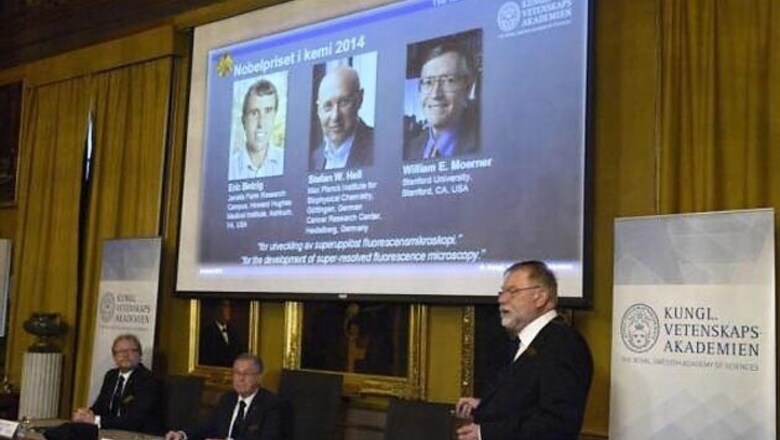
views
Stockholm/London: A German and two American scientists won the 2014 Nobel Prize for Chemistry on Wednesday for smashing the size barrier in optical microscopes, allowing researchers to see individual molecules inside living cells.
US citizens Eric Betzig and William Moerner and Germany's Stefan Hell won the prize for using fluorescence to take microscopes to a new level, making it possible to study things like the creation of synapses between brain cells in real time.
"Due to their achievements the optical microscope can now peer into the nanoworld," the Royal Swedish Academy of Sciences said as it awarded the 8 million crown ($1.1 million) prize.
Scientists, who have been looking down microscopes since the 17th century, had long thought there was a limit to what could be seen. In 1873, Ernst Abbe stipulated that resolution could never be better than 0.2 micrometres, or around 500 times smaller than the width of a human hair.
But the three Nobel winners bypassed this limit by tagging objects with fluorescent markers and scanning them to build up a far more detailed images. Today, such "nanoscopy" is used widely to visualise the internal molecular machinery of cells.
"This is very, very important to understanding how the cell works and understanding what goes wrong if the cell is diseased," Hell told a news conference by telephone after learning of the award.
Modern nanoscale microscopes can follow protein interactions involved in diseases like Alzheimer's, Parkinson's and cancer, or watch the transcription and translation of DNA to make proteins, or track the development of fertilised eggs as they divide and become embryos.
The previous limit meant optical microscopes could see objects about the size of the smallest bacteria, but not the detailed workings of individual components inside cells.
Light is a common theme of both this award and the Nobel Prize for Physics, which was given on Tuesday for advances in low-energy light-emitting diodes.
REVOLUTIONISED IMAGING
"It's no exaggeration to say that super-resolution fluorescence microscopy has revolutionised imaging, so this year's Nobel Prize for Chemistry is very well deserved," said Stefanie Reichelt, head of light microscopy at the Cancer Research UK Cambridge Institute, University of Cambridge.
Other techniques, such as electron microscopes, can provide greater resolution but require preparatory measures that kill cells, making them of no use for observing living processes.
"If you want to see living things, you must use something which does not destroy the sample, by using normal light," Anders Hagfeldt, a member of the Swedish academy and professor of physical chemistry at Uppsala University told Reuters.
"It was said it could not be done, basically. Now, with these three laureates here, it is possible."
Hell, who is director of the Max Planck Institute for Biophysical Chemistry in Germany, said he was "totally surprised" by the prize, while Betzig said he was stunned.
"I have been walking around a daze for the last hour, on a nice day in Munich, fearful that my life has changed," he told Reuters by phone from the southern German city, where he was scheduled to give a lecture on Wednesday.
Moerner, who is attending a conference in Recife, Brazil, told Reuters TV: "I knew there was a chance but really had no idea...it's something that makes your heart race."
Betzig works at the Howard Hughes Medical Institute in Ashburn, United States, while Moerner is professor at Stanford University.
Chemistry was the third of this year's Nobel prizes. The prize is named after Alfred Nobel, the inventor of dynamite, and has been awarded since 1901 for achievements in science, literature and peace in accordance with his will.
The chemistry prize has often lived in the shadow of physics and its star scientists such as Albert Einstein, though it was the field that was arguably closest to the heart of Nobel's own work in developing explosives.
As winners of the chemistry prize, the laureates enter an exclusive club of researchers such as nuclear pioneer Ernest Rutherford and Linus Pauling, the only person to win two Nobels on his own -- for chemistry in 1954 and peace in 1962.


















Comments
0 comment